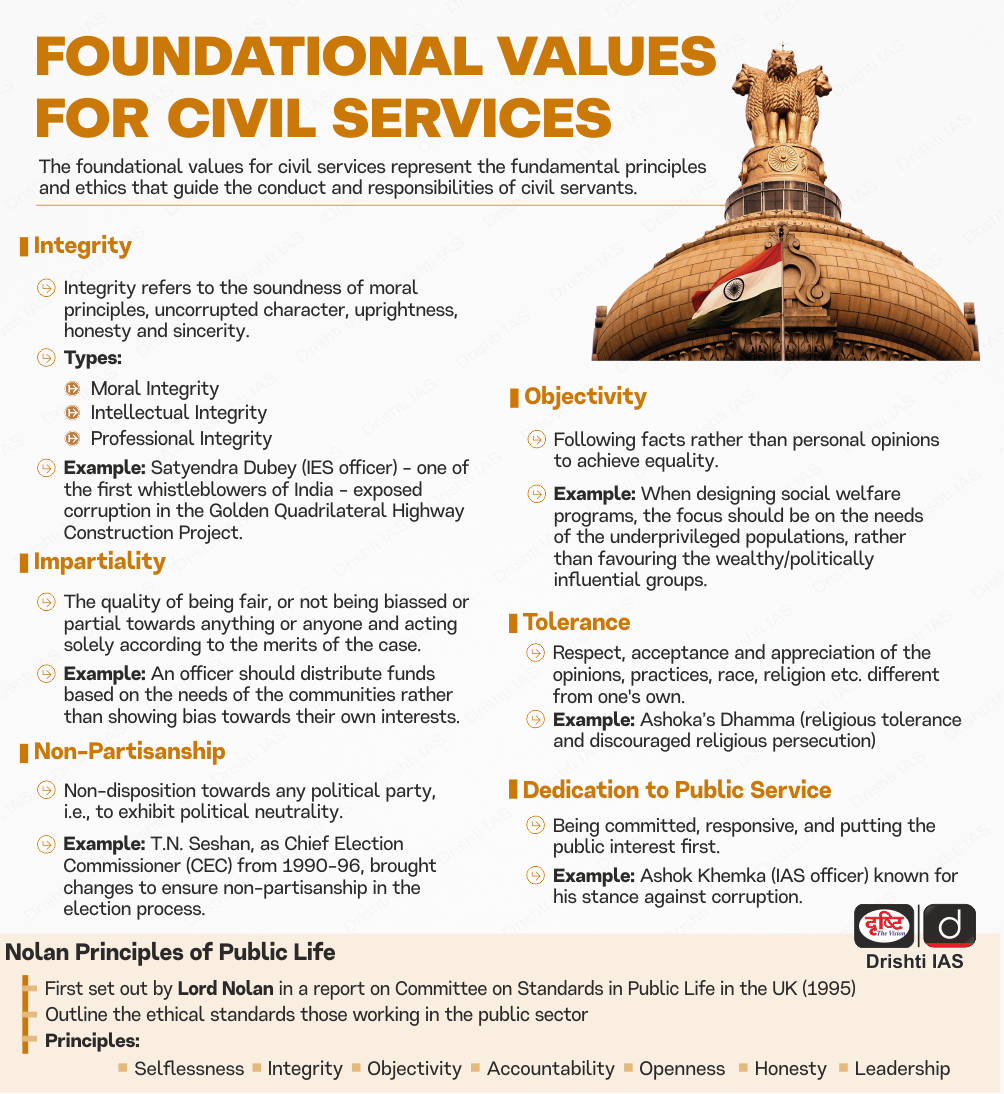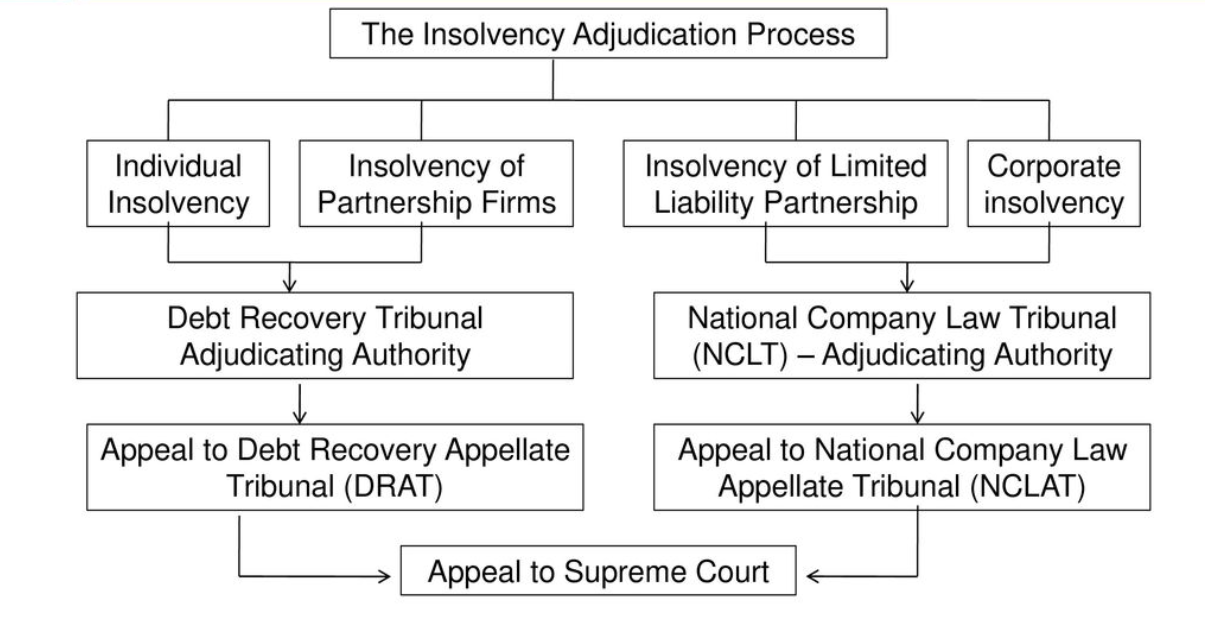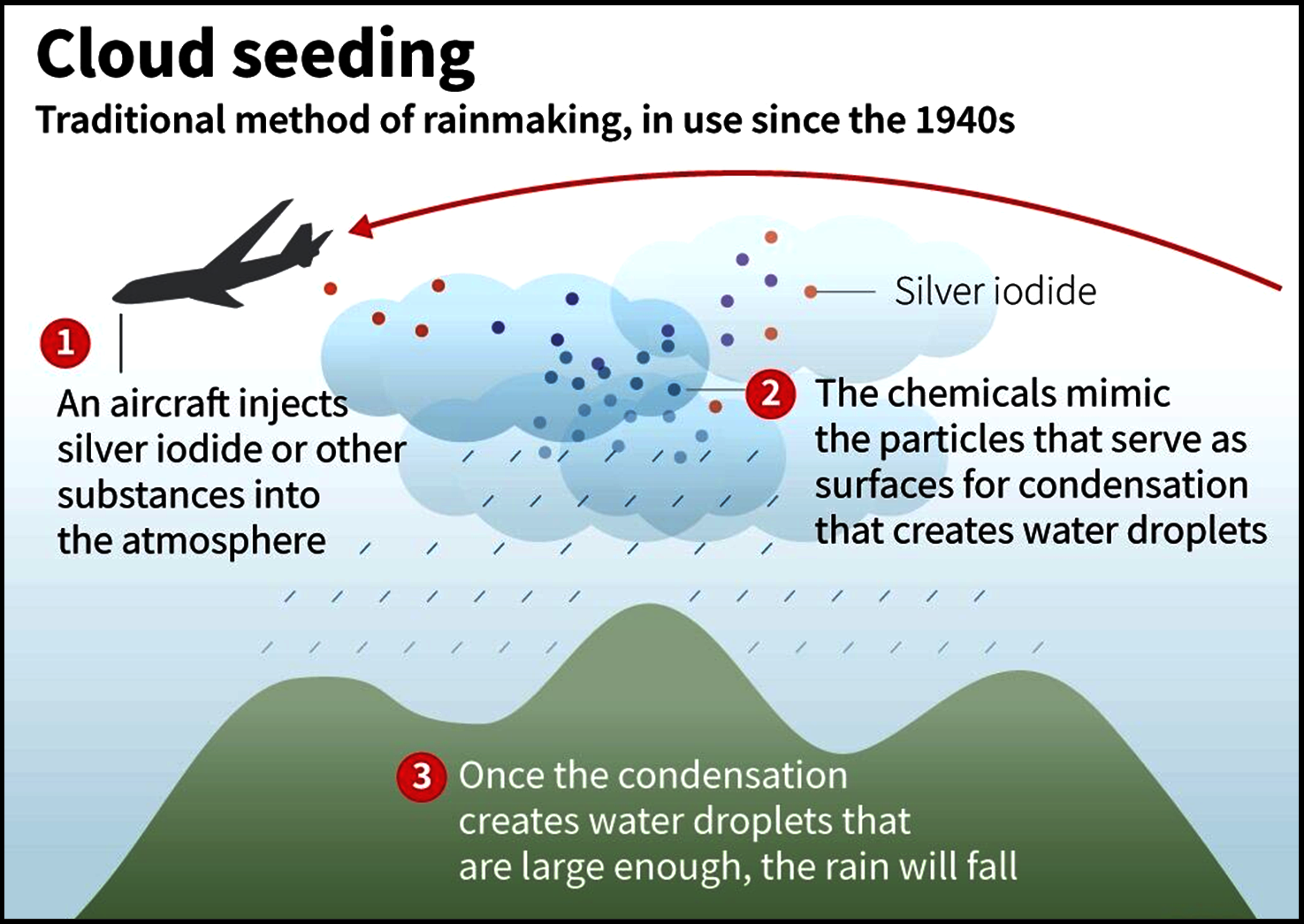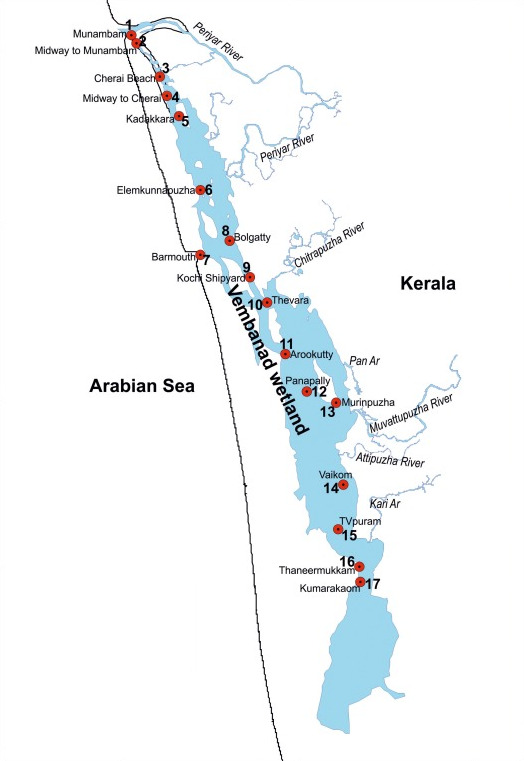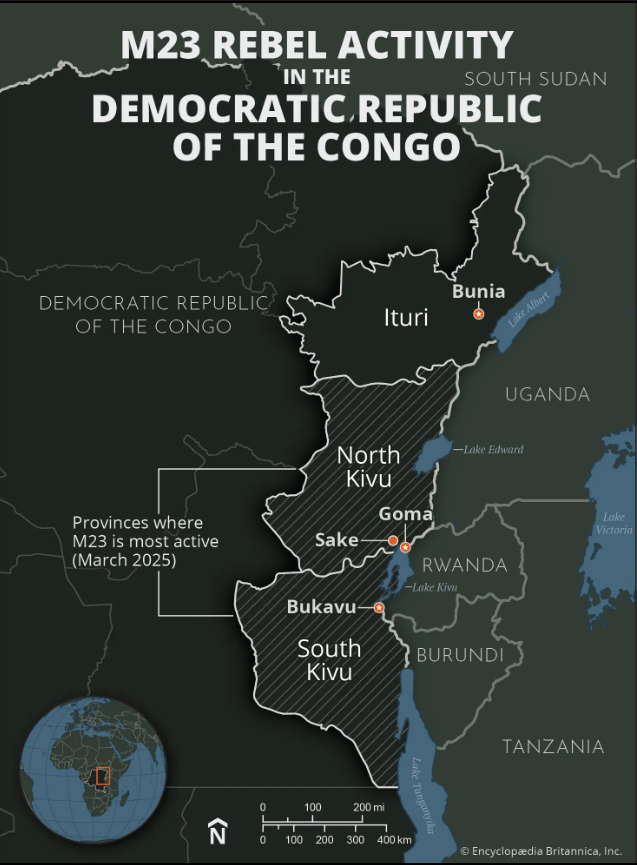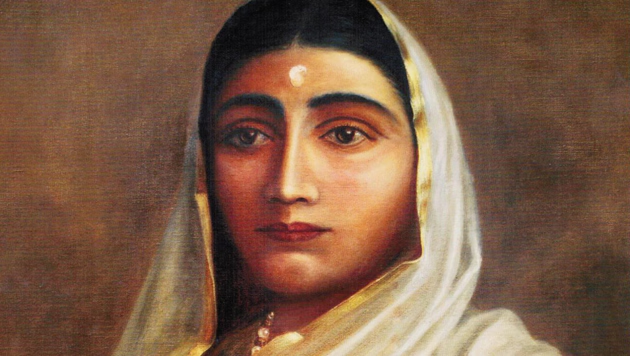Challenges Faced by the Civil Services
For Prelims: East India Company, Government of India Act, 1919, Union Public Service Commission, Joint State Public Service Commission, Lateral Entry Scheme
For Mains: Evolution and structure of Indian Civil Services, Challenges to neutrality and efficiency in the bureaucracy, Lateral Entry and Domain Specialization in Civil Services
Why in News?
The vital role of civil services in democracy stresses the need for transparency, lateral entry, and maintaining neutrality amid growing concerns over political interference and administrative inefficiencies.
How did India's Civil Service System Evolve?
- Colonial Beginnings: Initially, civil servants for the East India Company were nominated by the Company's Directors and trained at Haileybury College in London. They were then sent to India to administer the British Empire.
- This early system was deeply rooted in patronage, with few opportunities for Indians to join the administrative ranks.
- Introduction of the Merit-Based System (1854): The Macaulay Report of 1854, recommended replacing the patronage system (preference to political or familial connections) with a merit-based system (through competitive examinations).
- In response, the Civil Service Commission was established in 1854 in London, and the Indian Civil Service (ICS) examination began in 1855.
- This system was initially restrictive, as examinations were held only in London, with a limited number of seats for Indians.
- In response, the Civil Service Commission was established in 1854 in London, and the Indian Civil Service (ICS) examination began in 1855.
- Indian Participation in ICS: Satyendranath Tagore (brother of Shri Rabindaranath Tagore) became the first Indian to pass the ICS examination in 1864. Over the next few decades, the number of Indian candidates passing the ICS exam increased.
- Following the Montagu-Chelmsford Reforms (1919), the ICS exam began in India in 1922, held in Allahabad and later Delhi, alongside its continuation in London.
- Reforms in Police and Forest Services: Besides the ICS, services like the Imperial Police and Forest Service evolved, with Indian inclusion starting after 1920.
- The Indian Police recruited more Indians post-1939, while the Indian Forest Service was created in 1966 under the All India Services Act, 1951.
- Under British rule, civil services were initially classified as covenanted and uncovenanted.
- The 1887 Aitchison Commission reorganized them into Imperial, Provincial, and Subordinate services. Post-1919, Imperial Services were split into All India and Central Services.
- Formation of Public Service Commissions: The Government of India Act, 1919 provided for the establishment of a Public Service Commission in India to manage recruitment and control of public services.
- On the recommendations of Lee Commission (1924), the Public Service Commission was created in 1926, with Sir Ross Barker as the first Chairman.
- Further, the Government of India Act, 1935 established a Public Service Commission for the Federation and a Provincial Public Service Commission for each province or group of provinces.
- With the implementation of the Act, the Public Service Commission became the Federal Public Service Commission.
- Post-Independence Reforms and Consolidation: On 26th January 1950, with the adoption of the Indian Constitution, the Federal Public Service Commission became the Union Public Service Commission.
- The Chairman and Members of the former Commission transitioned to the new body under Article 378(1) of the Constitution.
- Constitutional Provisions: Article 312 of the Indian Constitution allows Parliament to create All India services, with recruitment handled by the UPSC. At the state level, recruitment is managed by State Public Service Commissions (SPSC).
- The UPSC and the SPSC are independent constitutional bodies. Articles 315 to 323 (Part XIV) of the Indian Constitution govern their composition, appointment, removal of members, and their powers and functions.
- Article 315: Constitution of Public Service Commissions (PSC) for the Union and States.
- Two or more states can agree to form a Joint State Public Service Commission (JSPSC), subject to a resolution passed by the legislature of each state.
- Article 316: Appointment and term of office of members of UPSC, JSPSC and SPSC.
- Article 317: Removal and suspension of members of UPSC, JSPSC and SPSC.
- Article 318: Power to make regulations for members and staff of the Commission.
- Article 319: Prohibition on members holding office after ceasing to be members.
What are the Challenges Faced by the Civil Services?
- Erosion of Neutrality: Increasing political interference has undermined bureaucratic independence and the merit system, promoting a spoils system in transfers and postings.
- The spoils system, where ruling parties appoint loyalists to administrative roles, was a common practice in the US until it was curtailed by the Pendleton Act of 1883. This system often resulted in the politicization of administration, undermining governance and institutional stability.
- The Supreme Court in Prakash Singh ruling (2006) mandated states to select Director General of Police (DGP) in consultation with the UPSC, which is often bypassed by the states highlighting political interference in civil services.
- Lack of Technical Expertise: Many bureaucrats are generalists, which limits their ability to address specialized, technical challenges in areas like infrastructure, health, and education.
- This can lead to inefficiency in addressing complex governance issues that require subject-specific knowledge.
- The Lateral Entry Scheme (LES), introduced to bring private sector expertise into senior bureaucracy, has made 63 appointments since 2019.
- However, it faces legal and political challenges due to the absence of a statutory framework and concerns over inadequate representation for marginalized communities.
- Corruption and Accountability Issues: Corruption remains endemic within the civil services, particularly at lower levels of administration.
- The Prevention of Corruption Act (PCA), 1988, lacks a clear definition of collusive corruption, which involves secret collaboration for mutual benefit, often harming the public interest. This legal gap weakens efforts to effectively address such corruption.
- Article 311 offers broad protection to civil servants, often delaying action against corruption.
- Despite efforts to address corruption, a lack of accountability and punitive action often allows corrupt practices to persist.
- Resistance to Change and Bureaucratic Rigidity: The civil services often operate in a highly procedural, hierarchical manner, which limits innovation and responsiveness.
- The emphasis on following procedures instead of focusing on results has created a barrier to the effective delivery of public services.
- Inefficient Use of Technology: Civil services were not sufficiently empowered by technology to meet the demands of modern governance.
- The absence of such capabilities limits the potential for enhancing citizen engagement and streamlining public services.
What Measures Can Strengthen the Civil Services in India?
- Reforming Recruitment and Lateral Entry: While the PSCs ensure merit-based recruitment, it needs reforms to include domain specialists through lateral entry at mid and senior levels.
- The NITI Aayog (Three-Year Action Agenda) recommended increasing lateral induction to bring in fresh ideas and expertise from outside the bureaucracy.
- The 2nd Administrative Reforms Commission (ARC), 2005 recommended lateral entry into the civil services to infuse specialized knowledge and expertise that traditional generalist officers might lack.
- Global Example: The UK and Singapore civil services regularly induct professionals from academia and the private sector.
- Performance Appraisal and Accountability: Integrate the Annual Confidential Report (ACR) with 360-degree feedback mechanisms to ensure objective performance reviews, as suggested by the 2nd ARC.
- Link promotions and postings with measurable outcomes aligned to Sustainable Development Goals (SDGs).
- Ensure protection from political interference while holding civil servants accountable through clear service rules and a strong Civil Services Board (CSB).
- Encouraging Specialization and Role Clarity: The Indian bureaucracy continues to be largely generalist in nature.
- Both the Surendranath Committee (2003) and the Baswan Committee (2016) recommended the promotion of domain specialization by identifying and grooming officers for sectoral leadership in areas such as health, infrastructure, and education.
- Capacity Building and Training: Mission Karmayogi offers a transformative path for strengthening India's civil services by shifting from rule-based to role-based governance.
- Its effective implementation must ensure personalized and continuous learning through the iGOT Karmayogi platform, with a strong emphasis on behavioral, functional, and domain-specific competencies, including ethics and digital readiness, to build a citizen-centric and future-ready civil service.
- Promoting Ethics and Integrity: Establish Ethics Commissions at central and state levels to guide officers.
- Introduce regular modules on public service values through the National Learning Week under the Mission Karmayogi, where civil servants take an annual oath to uphold integrity, ethics, and constitutional values.
- Strengthen institutions like the Lokpal, Central Vigilance Commission (CVC) to curb corruption.
- The 2nd ARC, 2005 recommended shifting to Article 309 for reasonable safeguards, enabling quicker disciplinary action.
- The UK’s Nolan Committee (1994) outlined seven core principles to guide public officials' ethical conduct, which includes selflessness, integrity, objectivity, accountability, openness, honesty, and leadership aimed at upholding ethics in public life.
- India must institutionalize such values to strengthen ethical standards in governance.
- Improving Work Culture and Grievance Redressal: Foster a people-centric and service-oriented work culture.
- Digitize grievance redressal through platforms like Centralised Public Grievance Redress and Monitoring System (CPGRAMS), and strengthen feedback loops.
- Encourage innovation and risk-taking by rewarding performance and protecting against vindictive action for bona fide decisions.
- Inclusive and Diverse Civil Services: Ensure representation of women and persons with disabilities not only in entry-level but also in leadership roles.
Conclusion
Civil services remain the steel frame of Indian democracy, but they must adapt to contemporary challenges. As India aspires to become a developed economy and inclusive society, civil servants must combine integrity with innovation and neutrality with accountability. The time is ripe for bold reforms to realign the bureaucracy with the demands of a 21st-century governance system.
|
Drishti Mains Question: Despite being the steel frame of Indian democracy, the civil services face issues of politicization and generalist dominance. Suggest reforms to address these issues. |
UPSC Civil Services Examination, Previous Year Questions (PYQs)
Mains
Q1. Identify ten essential values that are needed to be an effective public servant. Describe the ways and means to prevent non-ethical behavior in the public servants. (2021)
Q. “Institutional quality is a crucial driver of economic performance”. In this context suggest reforms in the Civil Service for strengthening democracy. (2020)
Role of Indigenous Communities in Biodiversity Conservation
For Prelims: Indigenous Peoples and Local Communities (IPLCs), Traditional Knowledge System, Congo Basin, Kunming-Montreal Global Biodiversity Framework (GBF), OECM, Nagoya Protocol,CBD, Biodiversity Management Committees (BMCs), Recognition of Forest Rights Act (FRA), 2006, PESA, 1996, Non-timber Forest Products (NTFPs), Biodiversity Heritage Sites (BHS), National Biodiversity Strategy and Action Plan (NBSAPs), Eco-Sensitive Zones (ESZs).
For Mains: Role of indigenous peoples and local communities (IPLCs) in biodiversity conservation.
Why in News?
Conservation laws globally often exclude indigenous and local communities (IPLCs), sidelining their role in biodiversity protection. In India, the Forest Rights Act, 2006 was a step towards recognizing IPLC rights, but state-led conservation models still prevail.
- The challenge remains to ensure that India’s conservation efforts fully empower IPLCs in managing and protecting their lands.
What Role does Indigenous Communities Play in Biodiversity Conservation?
- Preserve Traditional Knowledge: Indigenous tribes possess generations-old knowledge about medicinal plants, wildlife behavior, and sustainable resource use.
- E.g., The Kani tribe (Kerala) uses traditional knowledge to conserve medicinal plants in the Agasthyamalai Biosphere Reserve.
- Community-Led Forest Protection: Many tribal communities protect forests through sacred groves and community reserves.
- E.g., The Bishnoi community (Rajasthan) is known for protecting the Khejri tree and wildlife like blackbucks.
- Seed Conservation: Indigenous farming practices preserve native crop varieties and soil health.
- E.g., Tribes in Odisha and Nagaland practice jhum (shifting) cultivation with long fallow periods to maintain soil fertility.
- Coexistence with Wildlife: Many tribal groups follow cultural traditions that prohibit overhunting and promote harmony with wildlife.
- E.g., The Soliga tribe (Karnataka) coexists with tigers and elephants in the Biligiri Rangana Hills (BRT) Tiger Reserve.
What are the Key Frameworks in India Recognizing the Role of Indigenous Communities in Biodiversity Conservation?
- Biological Diversity Act (BDA), 2002: Through Biodiversity Management Committees (BMCs) at the local level, the initiative promotes the conservation of local plants, animals, and habitats, while also documenting traditional knowledge and fostering an inclusive approach to conservation.
- FRA, 2006: Scheduled Tribes and Other Traditional Forest Dwellers (Recognition of Forest Rights) Act (FRA), 2006 recognizes the rights of forest dwellers, including Adivasis and other traditional forest communities, over forest land and natural resources to manage forests sustainably.
- The Gram Sabha plays a central role in conserving biodiversity by managing, protecting, and regulating access to community forest resources, ensuring sustainable use and safeguarding the rights of forest-dwelling communities.
- Panchayats (Extension to Scheduled Areas) Act (PESA), 1996: PESA, 1996 mandates that local self-governments in tribal areas have control over land and natural resources, including forests and water bodies, thus ensuring local control over conservation practices.
- Joint Forest Management (JFM): The Joint Forest Management (JFM) and Eco-development programs involve local communities for forest conservation and sustainable resource use, with IPLCs managing non-timber forest products (NTFPs) and fuelwood to ensure ecosystem sustainability.
- National Biodiversity Action Plan (NBAP): The NBAP promotes participatory conservation, involving tribal communities in decision-making, respecting traditional knowledge, and strengthening community-based initiatives.
How Key Global Initiatives have Recognized the Role of IPLCs?
- Convention on Biological Diversity (CBD): The Kunming-Montreal Global Biodiversity Framework (GBF), adopted in 2022, emphasizes IPLCs participation.
- Target 3 aims to conserve 30% of global land and oceans by 2030 with full respect for Indigenous rights.
- Target 22 ensures their access to justice, land tenure, and decision-making participation.
- The COP-16 to the Convention on Biological Diversity (CBD) established a permanent Subsidiary Body to recognize the vital role of IPLCs in biodiversity conservation.
- Nagoya Protocol (2010): The Nagoya Protocol, adopted in 2010 under the CBD, ensures the fair sharing of benefits from genetic resources and promotes respect for traditional knowledge of IPLCs.
- UN Declaration on the Rights of Indigenous Peoples (2007): It is the most comprehensive international instrument detailing the rights of indigenous peoples, setting minimum standards for their recognition, protection, and promotion.
- It covers individual and collective rights, including cultural identity, education, health, and employment, and promotes non-discrimination and effective participation in matters affecting them.
What Measures can India Adopt to Further Integrate Indigenous Communities in Biodiversity Conservation?
- Strengthening the Implementation of the Forest Rights Act (FRA): Ensure effective implementation of the FRA by resolving land tenure issues, providing legal recognition to more forest-dwelling communities, and expediting CFR claims while involving gram sabhas in biodiversity management decisions.
- Recognition of Indigenous Knowledge in Conservation Planning: Document and integrate IPLCs' traditional ecological knowledge (TEK) into biodiversity strategies, and establish platforms to share and promote their conservation practices within legal and policy frameworks.
- Incorporate IPLCs in the "30 by 30" Agenda: While India commits to protecting 30% of its land and marine areas by 2030, it must ensure that IPLCs are included in the design and management of these areas, reflecting their rights and participation.
- Prioritize the inclusion of IPLCs in any new conservation areas or initiatives, ensuring that their rights are not violated in the name of conservation.
- Traditional Knowledge in Governance: Government and research bodies should work closely with IPLCs to document and safeguard traditional knowledge systems, ensuring these are not exploited without fair compensation.
- Biodiversity Management Committees need to be made fully functional and empowered to engage in decision-making processes regarding local biodiversity.
- Financial Support for Community Conservation Projects: Establish funding for community-led conservation projects and provide incentives like eco-certification and carbon credits to support IPLCs in implementing sustainable biodiversity conservation strategies on their lands.
Conclusion
India’s conservation framework stands out globally for its inclusive approach by legally recognising the rights of Indigenous Peoples and Local Communities (IPLCs). Strengthening laws like the Forest Rights Act (FRA) and ensuring participatory governance through Gram Sabhas and Biodiversity Management Committees (BMCs) is essential for balancing biodiversity preservation with social justice.
|
Drishti Mains Question: Discuss how India’s legal and policy frameworks have promoted inclusive biodiversity conservation. |
UPSC Civil Services Examination, Previous Year Questions (PYQs)
Prelims
Q. Under which Schedule of the Constitution of India can the transfer of tribal land to private parties for mining be declared null and void? (2019)
(a) Third Schedule
(b) Fifth Schedule
(c) Ninth Schedule
(d) Twelfth Schedule
Ans: (b)
Q. Under the Scheduled Tribes and Other Traditional Forest Dwellers (Recognition of Forest Rights) Act, 2006, who shall be the authority to initiate the process for determining the nature and extent of individual or community forest rights or both? (2013)
(a) State Forest Department
(b) District Collector/Deputy Commissioner
(c) Tahsildar/Block Development Officer/Mandal Revenue Officer
(d) Gram Sabha
Ans: (d)
Mains
Q. How is the Government of India protecting traditional knowledge of medicine from patenting by pharmaceutical companies? (2019)
SC’s Flags Gaps in Bankruptcy Resolution Process
For Prelims: Supreme Court, Article 142, Insolvency and Bankruptcy Board of India, National Company Law Tribunal, Debt Recovery Tribunal
For Mains: Insolvency and Bankruptcy Code Achievements and Challenges, Judicial Oversight and Role of NCLT in Corporate Insolvency
Why in News?
The Supreme Court (SC) of India, invoking Article 142, struck down a resolution plan under the Insolvency and Bankruptcy Code (IBC), 2016 and ordered liquidation of the debt-ridden company instead.
- This highlights growing concerns over the consistency and effectiveness of the IBC in achieving timely and constructive resolutions.
What are the Key Issues Flagged by the Supreme Court in Bankruptcy Resolution?
- Non-Conformity with Statutory Provisions: The resolution plan approved in the Bhushan Power & Steel Ltd. case did not conform to Section 30(2) of the IBC, which mandates that resolution plans must be in the best interests of creditors and meet statutory requirements.
- Lapses by the Resolution Professional: The resolution professionals (RPs) failed to perform due diligence and allowed a flawed resolution plan to proceed, highlighting concerns over competence, accountability, and regulatory oversight of RPs in the insolvency process.
- Weaknesses in the Committee of Creditors (Coc): The CoC, responsible for assessing the plan, did not exercise due diligence and commercial wisdom, approving a plan that ultimately harmed the interests of creditors.
- COC spearheads the Corporate Insolvency Resolution Process (CIRP), under the Insolvency and Bankruptcy Code (IBC) 2016.
- Judicial Oversight Gaps: The National Company Law Tribunal’s failure to reject the flawed resolution plan under Section 31(2) of the IBC exposed gaps in judicial oversight, underscoring the need for stronger tribunal-level scrutiny to uphold the IBC’s integrity.
What is Insolvency and Bankruptcy Code (IBC), 2016?
- About: The IBC, 2016 is India’s comprehensive bankruptcy law that consolidates and streamlines existing insolvency frameworks for companies, partnership firms, and individuals.
- Insolvency refers to a situation where liabilities exceed assets, and debts cannot be paid as they fall due. Bankruptcy is the legal declaration of such inability to pay debts.
- The T.K. Vishwanathan Committee (Bankruptcy Law Reforms Committee) 2015 recommended a unified framework for resolving corporate and personal insolvencies, which led to the enactment of the Insolvency and Bankruptcy Code (IBC), 2016.
- The IBC establishes a time-bound, creditor-driven process for resolving insolvency, aiming to improve credit discipline, resolve stressed assets efficiently, and strengthen the overall business environment.
- It was primarily introduced to address the bad loan crisis in India’s banking sector.
- Regulating Authority: The Insolvency and Bankruptcy Board of India (IBBI), a statutory body established under the IBC, 2016, is responsible for formulating rules and regulations for insolvency resolution in India.
- It comprises members from the Ministry of Finance, Ministry of Corporate Affairs, and the Reserve Bank of India.
- Adjudicating Authority: In the IBC, the Adjudicating Authority for corporate persons is the National Company Law Tribunal (NCLT), while for individuals and firms, it's the Debt Recovery Tribunal (DRT).
- The NCLT handles cases involving corporate debtors and their guarantors, while the DRT deals with insolvency matters of individuals and partnership firms other than Limited Liability Partnerships.
- Corporate Insolvency Resolution Process: It is a time-bound legal mechanism under the IBC, 2016, designed to resolve the financial distress of companies that default on debt repayment.
- It can be initiated by financial creditors, operational creditors, or the defaulting company itself by filing an application with the NCLT which appoints an Interim Resolution Professional (IRP) who takes control of the company's management.
- The IRP verifies creditor claims and forms a CoC, which evaluates and votes on a resolution plan within 180 to 330 days.
- The Adjudicating Authority may order liquidation if no resolution plan is filed within 180 days (or the extended period) from the insolvency commencement date.
- It can be initiated by financial creditors, operational creditors, or the defaulting company itself by filing an application with the NCLT which appoints an Interim Resolution Professional (IRP) who takes control of the company's management.
- Key Achievements: Since its inception, the IBC has facilitated the resolution of over Rs 3.16 lakh crore of debt in 808 cases, contributing to better recovery rates compared to older mechanisms such as the DRT and Lok Adalat.
- The IBC was described as a "lighthouse of a new era", promoting credit discipline and contributing significantly to the historic reduction of non-performing assets (NPAs).
- As per the RBI’s report, Net NPAs were at a 12-year low of 0.6% in June 2024, showcasing the IBC's effectiveness in improving credit discipline.
- The IBC contributed significantly to India’s improved rank in the World Bank's Doing Business Report (DBR), with India rising from 142nd in 2014 to 63rd in 2019, before the report's discontinuation.
- The IBC was described as a "lighthouse of a new era", promoting credit discipline and contributing significantly to the historic reduction of non-performing assets (NPAs).
What are the Key Issues Related to IBC?
- Delay in Resolution Process: One of the key issues with IBC is the delay in completing insolvency resolutions.
- While the IBC aims for a 180-day timeline, frequent extensions and delays in the process have led to asset devaluation, creditor losses, and overall inefficiency in resolving cases.
- This undermines the core purpose of the Code—quick and effective resolution.
- Imbalance in the CoC: The CoC, which plays a crucial role in approving resolution plans, is heavily dominated by financial creditors (banks and financial institutions).
- This often leaves operational creditors (suppliers, employees) underrepresented, leading to biased resolutions in some cases that may not account for the needs of smaller creditors or result in an unfair distribution of assets.
- Lack of Legal Certainty in Cross-Border Insolvency: The IBC framework lacks a comprehensive approach to cross-border insolvency, causing challenges in the resolution of multinational companies with operations or assets in multiple countries.
- The absence of clear legal frameworks and coordination mechanisms with other countries can result in jurisdictional conflicts, prolonged litigation, and asset mismanagement.
- Inadequate Protection of Debtors’ Interests: While IBC prioritizes the recovery of debts, it often places excessive emphasis on creditor interests at the expense of the debtor’s right to rehabilitation.
- The insolvency process tends to push for liquidation rather than restructuring, particularly in cases of distressed businesses that could still be viable with the right support.
- Inefficiency in Liquidation Process: The liquidation process under the IBC has been marred by inefficiencies such as poor asset valuation, lack of transparency, and delays in the sale of assets. This results in lower recoveries for creditors and market distortion.
What Measures Can be Adopted to Strengthen the IBC?
- Timely Resolution and Swift Judicial Action: The legal framework for IBC should prioritize speed and efficiency. Timely judicial intervention will prevent prolonged legal disputes and economic uncertainty.
- Strengthening the IBC’s institutional framework, including improving the capacity of the NCLT, will ensure smoother operations and maintain confidence in the insolvency resolution system.
- Robust Oversight with Targeted Penalties: The IBC must be supported by robust institutional mechanisms for oversight, particularly to prevent malpractices during the resolution process.
- Any illegalities uncovered after the resolution plan has been implemented should result in targeted penalties for those responsible.
- Balanced Approach to Debtor and Creditor Interests: Reassess the code to provide a more balanced approach that ensures the interests of corporate debtors (especially in cases of distressed businesses) are fairly protected without compromising creditor rights.
- A redefined "commercially viable" solution would encourage more sustainable resolutions.
- Enhanced Digitalisation of IBC Procedure: Promote digitalisation to connect all IBC stakeholders, ensuring transparency, reducing data gaps, and speeding up decisions.
- Expand the Pre-Packaged Insolvency Resolution Process (PPIRP) to large corporations to prevent value erosion from delays.
- Customizing IBC for Emerging Sectors: Amend IBC provisions to address the specific challenges faced by emerging sectors like fintech, digital businesses, and green industries, providing them with sector-specific insolvency solutions.
Conclusion
The Supreme Court’s intervention highlights critical gaps in the IBC process. Despite its success in improving debt recovery, persistent delays, weak oversight, and imbalance in stakeholder interests hinder its effectiveness. Strengthening institutional capacity, ensuring timely resolutions, and adopting a more balanced and sector-specific approach are key to restoring the IBC’s credibility.
|
Drishti Mains Question: The Insolvency and Bankruptcy Code was hailed as a major economic reform in India. Do recent developments suggest a need for structural overhaul? Substantiate with examples. |
UPSC Civil Services Examination, Previous Year Question (PYQ)
Prelims
Q. Which of the following statements best describes the term ‘Scheme for Sustainable Structuring of Stressed Assets (S4A)’, recently seen in the news? (2017)
(a) It is a procedure for considering ecological costs of developmental schemes formulated by the Government.
(b) It is a scheme of RBI for reworking the financial structure of big corporate entities facing genuine difficulties.
(c) It is a disinvestment plan of the Government regarding Central Public Sector Undertakings.
(d) It is an important provision in ‘The Insolvency and Bankruptcy Code’ recently implemented by the Government.
Ans: (b)
Cloud Seeding
The Delhi Cabinet has approved a project to conduct cloud seeding trials aimed at addressing air pollution and water scarcity.
- Cloud Seeding: It is a weather modification technique that enhances precipitation by dispersing chemicals like silver iodide, potassium iodide, or dry ice into clouds, serving as nuclei for water droplet formation, leading to rainfall.
- It can help combat air pollution, especially during periods of high Air Quality Index (AQI) readings.
- Cloud seeding may increase water availability and result in economic, environmental, and human health benefits.
- Types of Cloud Seeding: Static cloud seeding, which involves introducing ice nuclei into cold clouds to form ice crystals or snowflakes.
- Dynamic cloud seeding, which stimulates rainfall by enhancing vertical air currents and promoting rain cloud growth.
- Hygroscopic cloud seeding, which uses fine particles of salts to increase cloud droplet size.
- Glaciogenic cloud seeding, which induces ice formation in supercooled clouds to trigger precipitation. It is used for enhancing snowfall, increasing mountain snowpack, inducing rain in drought-hit areas, and reducing air pollution.
| Read more: Cloud Seeding to Reduce Air Pollution |
Vembanad Lake
Vembanad Lake, India's longest lake, is facing severe degradation from encroachment, pollution, and invasive species, leading to a 66% decline in fish catch and reduced flood control capacity.
Vembanad Lake:
- Vembanad Lake, largest in Kerala also known as Vembanad Kayal, and Kochi Lake (in Kochi), spanning 96.5 km across Alappuzha, Kottayam, and Ernakulam.
- It has been a Ramsar wetland (second-largest Ramsar site after Sundarbans) since 2002 and is part of the National Wetlands Conservation Programme.
- It is fed by 4 rivers-Meenachil, Achankovil, Pampa, and Manimala, and separated from the Arabian Sea by a narrow barrier island.
- It hosts the annual Vallam Kali (Nehru Trophy Boat Race) in August.
- The Kumarakom Bird Sanctuary lies on its eastern shore.
- In 2019, Kochi's Willingdon Island was formed from the lake.
- The 1,252 m-long Thanneermukkom Saltwater Barrage, India’s largest mud regulator, has been operational since 1976, divides Vembanad Lake into freshwater and brackish water sections.
| Read More: Vembanad Lake, World Wetlands Day 2025 |
Democratic Republic of Congo (DRC)
The Democratic Republic of Congo (DRC) is holding peace talks with Rwanda and the M23 militias to protect its mineral-rich regions and ensure national stability.
- The US is facilitating peace talks aiming to secure peace and establish bilateral critical mineral deals with the DRC.
- In February 2025, Rwanda-backed M23 militia seized cities like Goma and Bukavu, and threatened the Bisie tin mine, world's 4th-largest producer of tin concentrates.
- The North and South Kivu provinces in DRC are rich in tin, tungsten, and tantalum (coltan ore) (3T minerals).
- The DRC is the largest source of cobalt (70% of global supply) and 40% of the world's coltan, used in tantalum capacitors for electronics due to its high charge retention.
- The M23 militia, a Tutsi-led rebel group in eastern DRC, fights to protect Tutsi communities. They battle the DRC government and a Hutu-linked militia connected to the 1994 Rwandan genocide.
- M23 is believed to be supported by Rwanda, while Hutu has backing from some Hutu groups in the region.
- The DRC, Africa’s 2nd-largest country, has the mineral-rich Katanga Plateau (cobalt, copper, tin, uranium, diamonds).
- Its capital Kinshasa lies on the Congo River, the only African river to cross the equator twice.
| Read More: DRC Conflict and M23 Militia |
Insider Trading
The Securities and Exchange Board of India (SEBI) has alleged the nephew of the billionaire Gautam Adani, shared unpublished price sensitive information and breached regulations aimed at preventing insider trading.
- About Insider Trading: Insider trading refers to the illegal practice of buying or selling a publicly traded company’s stock or securities based on material, non-public information (MNPI) about the company.
- It gives the trader an unfair advantage over other investors and undermines market fairness.
- An insider can include company executives, directors, employees with access to confidential data (impacts stock prices), their relatives or associates, and professionals such as lawyers, bankers, or auditors working with the company.
- In India, insider trading is prohibited under the SEBI Act, 1992, and regulated by the SEBI (Prohibition of Insider Trading) Regulations, 2015, which set the rules for prohibiting and restricting insider trading.
- Front-running is an illegal practice where traders or brokers use advance knowledge of pending client trades to profit from expected price movements.
- Unlike insider trading, it exploits knowledge of large orders rather than non-public company information.
- Both practices are prohibited under SEBI regulations in India.
| Read More: Front Running and Insider Trading |
300th Birth Anniversary of Ahilyabai Holkar
The Maharashtra Cabinet held its maiden meeting outside Mumbai in Chondi to mark the 300th birth anniversary (31st May 2025) of Malwa Queen Ahilyabai Holkar and to honor her legacy.
- Birth & Background: Ahilyabai was born on 31st May 1725 in Chondi, Ahmednagar (Maharashtra), her father, Mankoji Rao Shinde, was the village head.
- Marriage & Early Life: She was married to Khanderao Holkar in 1733, the son of Malhar Rao Holkar, the ruler of Malwa and the founder of the Holkar dynasty.
- Ahilyabai was widowed in 1745 after Khanderao died in the siege of Kumher Fort.
- Malhar Rao Holkar prevented Ahilyabai from committing sati and trained her in military and administrative matters.
- Ascension to Power: After the death of Malhar Rao Holkar in 1766 and her son Male Rao Holkar in 1767, Ahilyabai Holkar took charge of Malwa and became the ruler of Indore in 1767.
- She appointed Tukoji Rao Holkar as army commander and made Maheshwar in Madhya Pradesh the Holkar dynasty’s capital.
- Social and Economic Contributions: Ahilyabai Holkar rebuilt the Somnath and Kashi Vishwanath temples, restoring key Jyotirlingas of Lord Shiva. She patronised scholars like Khushali Ram, Marathi poet Moropant, and Shahir Anantaphandi.
- She promoted women’s education, widow remarriage, and opposed practices like sati, while uplifting Bhil, Gond tribes, and lower castes.
- She made Maheshwar and Indore major trade hubs, promoting the Maheshwari weaving industry and making Maheshwari sarees renowned across India, now registered with a Geographical Indication (GI) tag.
Rabies
3 vaccinated children in Kerala died from rabies despite receiving proper vaccine doses has intensified concerns over timely intervention.
- Victims sustained deep head and hand injuries, areas with dense nerve networks, allowing the virus rapid access to the nervous system.
- Rabies infects the central nervous system (CNS) via nerves, and bites in sensitive regions reduce the effectiveness of post-bite vaccinations.
- First aid failure (not washing wounds with soap and water) significantly increased the risk of virus transmission.
- About Rabies: It is a fatal zoonotic viral disease that affects the CNS of mammals, including humans.
- It is caused by the rabies virus and is almost 100% fatal once symptoms appear.
- Rabies is 100% preventable with timely medical care before symptoms appear.
- The virus is present in the saliva of infected animals (dogs, bats, raccoons, foxes) and enters the human body through bites, scratches, or licking of open wounds or mucous membranes.
- The virus reaches the brain through the nerves, triggers brain inflammation (encephalitis), leads to serious neurological issues, and results in death.
- WHO reports that India bears the highest rabies burden, accounting for 36% of global rabies deaths.
- It is caused by the rabies virus and is almost 100% fatal once symptoms appear.
| Read More: Rabies |

